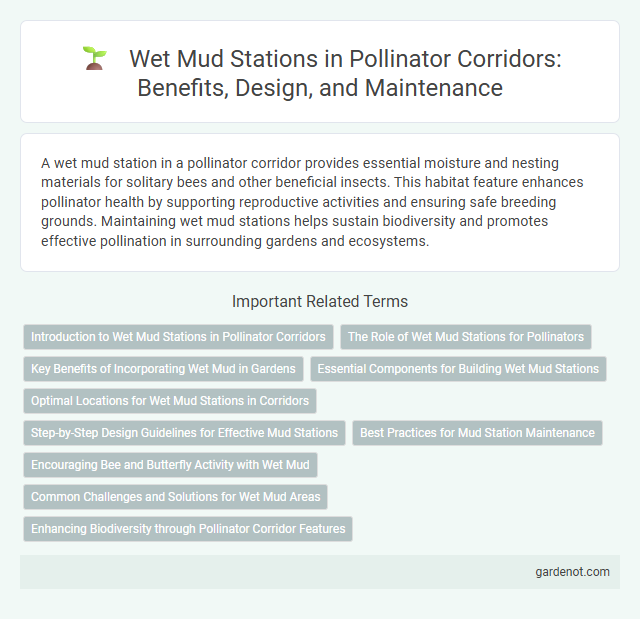A wet mud station in a pollinator corridor provides essential moisture and nesting materials for solitary bees and other beneficial insects. This habitat feature enhances pollinator health by supporting reproductive activities and ensuring safe breeding grounds. Maintaining wet mud stations helps sustain biodiversity and promotes effective pollination in surrounding gardens and ecosystems.
Introduction to Wet Mud Stations in Pollinator Corridors
Wet mud stations serve as essential microhabitats within pollinator corridors by providing vital resources for solitary bees and other pollinators. These stations offer moist, clay-rich soil that supports nesting and moisture needs crucial for the reproductive cycle of ground-nesting pollinators. Incorporating wet mud stations enhances biodiversity and improves pollination efficiency across agricultural and natural ecosystems.
The Role of Wet Mud Stations for Pollinators
Wet mud stations provide essential nesting materials, such as moist soil and clay, that many solitary bees and pollinators require for burrowing and constructing nests. These stations enhance pollinator habitats by offering safe, resource-rich environments that support reproductive success and population growth. Incorporating wet mud stations into pollinator corridors strengthens ecosystem resilience by promoting biodiversity and facilitating effective pollination services.
Key Benefits of Incorporating Wet Mud in Gardens
Incorporating wet mud stations in gardens provides essential moisture and mineral-rich habitats that support diverse pollinator species, including bees and butterflies. Wet mud offers critical resources for solitary bees to build nests and lay eggs, enhancing local biodiversity and pollination efficiency. Creating these natural mud habitats helps improve garden health by fostering pollinator activity, which increases flowering and fruit production.
Essential Components for Building Wet Mud Stations
Wet mud stations require a consistent supply of clean, moist clay or mud, which is crucial for pollinators like mason bees to construct their nests. Placement near flowering plants and a sheltered, sunny location enhances usability and protection from predators. Incorporating organic matter such as leaves or straw helps maintain moisture and provides a natural environment that supports successful nesting.
Optimal Locations for Wet Mud Stations in Corridors
Wet mud stations are most effective in pollinator corridors when situated near water sources and areas with abundant flowering plants, ensuring easy access to moist soil essential for bee hydration and mineral intake. Ideal locations include forest edges, riparian zones, and meadow boundaries where soil remains consistently damp but not waterlogged. Positioning these stations within 50 meters of diverse floral resources enhances pollinator visitation and supports overall corridor biodiversity.
Step-by-Step Design Guidelines for Effective Mud Stations
Create wet mud stations by selecting a shaded, well-drained area with access to water to maintain consistent moisture. Use a shallow container filled with a mix of garden soil, fine sand, and organic matter to provide ideal mud texture for pollinators like bees. Regularly monitor moisture levels and refresh the mud to ensure the habitat remains attractive and supportive for nesting pollinators within the corridor.
Best Practices for Mud Station Maintenance
Regularly rotating wet mud stations ensures optimal moisture levels, promoting healthy pollinator activity and preventing fungal buildup. Removing debris and replenishing fresh mud with balanced mineral content supports diverse pollinator species' nesting needs. Strategic placement in shaded, well-drained areas minimizes contamination and sustains station longevity.
Encouraging Bee and Butterfly Activity with Wet Mud
Wet mud stations create ideal environments for bees and butterflies by providing essential moisture and minerals critical for their survival and reproduction. These wet areas support hydration and enable pollinators to access nutrients that enhance their strength and vitality, directly boosting pollination efficiency. Maintaining damp soil patches within pollinator corridors increases biodiversity and promotes healthier ecosystems by attracting diverse pollinator species.
Common Challenges and Solutions for Wet Mud Areas
Wet mud stations often present challenges such as waterlogging and low oxygen levels, which can hinder pollinator activity and plant growth. Implementing proper drainage systems and selecting native, water-tolerant plant species helps maintain habitat quality and supports diverse pollinator populations. Regular monitoring and adaptive management are essential to address seasonal fluctuations and prevent stagnation in wet mud corridors.
Enhancing Biodiversity through Pollinator Corridor Features
Wet mud stations within pollinator corridors provide essential breeding and foraging habitats for solitary bees and other pollinators, significantly boosting local biodiversity. These moist, nutrient-rich areas support diverse plant species, which attract a wide range of pollinator insects crucial for ecosystem resilience. Incorporating wet mud stations into corridor design enhances habitat connectivity and promotes sustainable pollination services vital for agricultural productivity and natural vegetation.
Wet mud station Infographic

 gardenot.com
gardenot.com